When it comes to vegetables, few can rival the versatility of zucchini. This remarkable squash can be used in various dishes, from refreshing salads to delicious pasta recipes. It’s the star ingredient in the ever-popular zucchini noodles, also known as zoodles. Given its ubiquity in my household, it’s crucial to understand how to store zucchini effectively, ensuring that it remains fresh and crisp for as long as possible.
Despite its inherent resilience, zucchini requires proper storage techniques to maximize its shelf life. You can make the most of this super-useful vegetable in the refrigerator and freezer by employing the appropriate methods. With these practices, you’ll never have to worry about your zucchinis spoiling prematurely again!
What Is Zucchini?
Zucchini, a versatile summer squash, is commonly called green squash due to its vibrant color. Belonging to the Cucurbitaceae plant family, zucchini traces its origins back to the Americas through the Cucurbita genus. However, it was through Italian cultivation in the nineteenth century that modern zucchini as we know it today came into existence. Fascinatingly, the name “zucchini” is derived from the Italian word “zucca,” which translates to “squash.” In French, this delightful vegetable is called a “courgette.”
Widely available in grocery stores, the most commonly found type of zucchini is the dark-green variety known as “Black Beauty.” Although it is classified as a fruit, zucchini is predominantly consumed as a vegetable due to its savory flavor and culinary versatility.
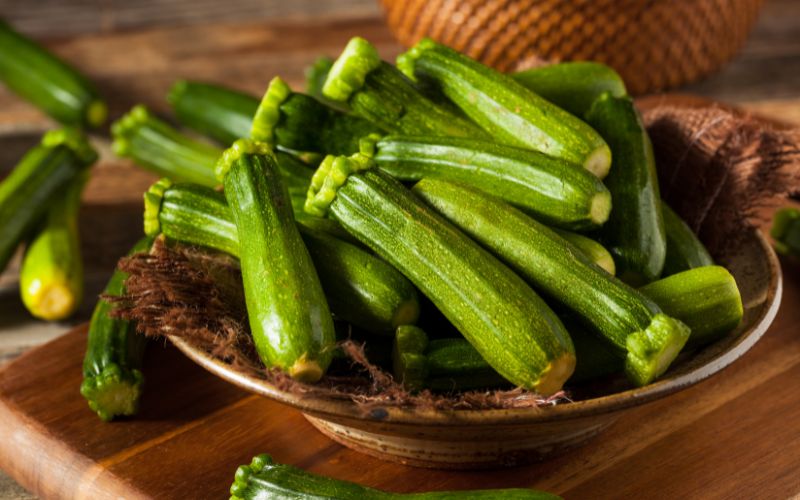
When it comes to cooking, zucchini offers countless possibilities. For instance, you can enhance the flavors of vegetable soup by adding diced zucchini, which infuses a subtle sweetness while adding a delightful texture. Alternatively, you can elevate a sheet-pan dinner by combining zucchini slices with diced chicken thighs, coating them in aromatic olive oil and spices, and roasting them to perfection.
Raw zucchini slices are excellent for those seeking a refreshing and nutritious snack or side dish. Pair them with creamy hummus or other delectable dips to create a delightful flavor combination. Moreover, zucchini takes center stage in various containers, such as bread and noodles. The latter, known as zoodles, have gained significant popularity as a low-carb pasta substitute.
How to Choose Zucchini?
The process is quite simple when selecting the perfect zucchini from either the grocery store or the farmer’s market. All you need to do is look for certain qualities that indicate freshness and quality. Opt for zucchinis that are on the smaller side, as they tend to be more flavorful. Choosing ones that feel firm to the touch is also essential, indicating they are not overly ripe. Additionally, make sure to inspect each zucchini closely and avoid any that have nicks or blemishes on their skin.
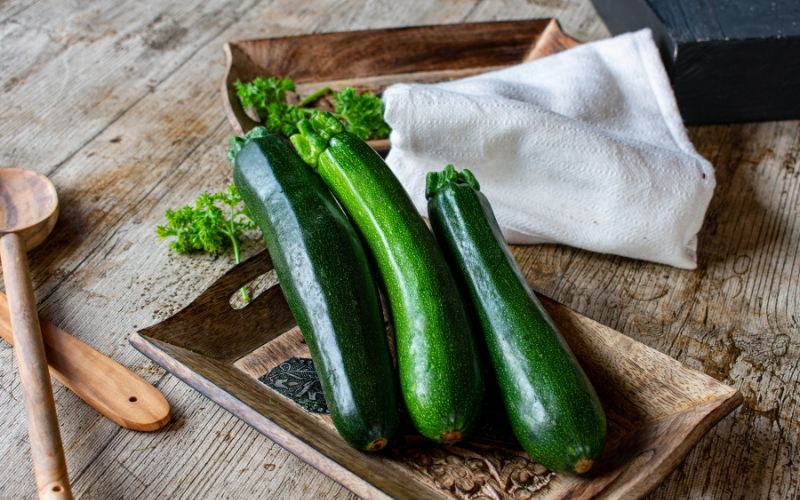
In terms of appearance, the best zucchinis typically have dark, dark-green skin, which is a clear sign of their freshness. On the other hand, more giant zucchinis may not be as desirable due to their tendency to contain a higher water content. Therefore, it’s generally recommended to go for the smaller ones, as they are more likely to have a better texture and flavor.
Although zucchini is known to be at its tastiest during the late summer months when it is in season, you don’t have to limit yourself to only enjoying it. Thanks to the availability of zucchini year-round at grocery stores, you can easily incorporate this versatile vegetable into your meals regardless of the season.
Ways to Store Zucchini
Depending on your intended recipe, numerous methods are available for storing zucchini. Let’s explore a few different ways to keep zucchini:
- Leaving fresh zucchini out at room temperature is suitable if you cook the vegetable within a few days of purchase. Storing it on the counter at room temperature allows it to retain its freshness. It is recommended to lightly rinse the zucchini with cold water before cooking to remove any dirt or debris.
- If you anticipate using the zucchini more than a few days after purchase, storing it in the refrigerator is the way to go. To do this, place the fresh zucchini in a paper bag and store it in the fridge. This method ensures that the zucchini will stay fresh for over a week. A crisper drawer or a paper bag must be used to allow proper air circulation and prevent wilting. Avoid sealing the zucchini in a plastic bag or airtight container, as this can impact its quality due to the lack of airflow.
- A flash-freezing process can prevent the cut zucchini pieces from sticking together for long-term storage in the freezer. Begin by arranging the zucchini slices in a single layer on a baking sheet and freezing them for a couple of hours. Once flash-frozen, transfer them to an airtight container or freezer bag and return them to the freezer. This method allows you to store frozen zucchini for up to three months. However, it is essential to note that exceeding this time frame may result in freezer burn. To use frozen zucchini, you can either thaw it under cold water or let it defrost in the refrigerator.
How to Store Zucchini in the Fridge
Zucchini is a vegetable that flourishes in dry conditions, making it essential to store it appropriately to maintain its freshness. To keep your zucchini from spoiling, it is recommended to place it in the crisper drawer of your refrigerator. It is best to store it whole and consider using a plastic or paper bag, ensuring that one end of the bag is open for proper ventilation. By doing so, you can maintain the minimal humidity level that zucchini requires to stay fresh longer.
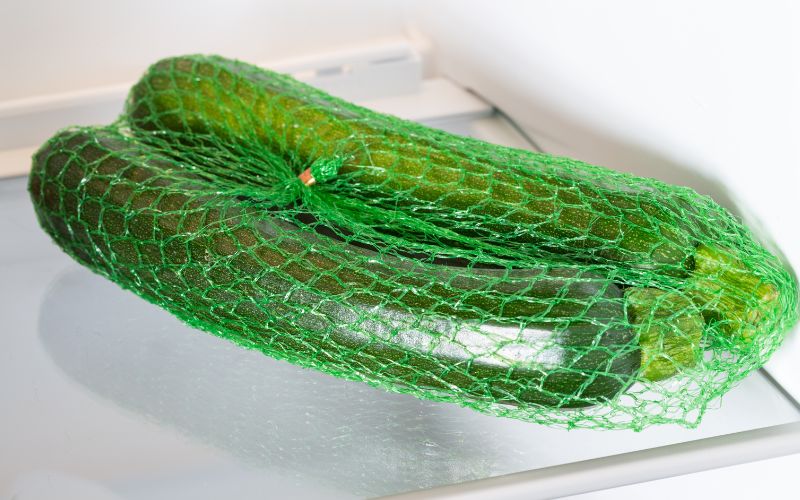
When stored properly, zucchini can last anywhere from one to two weeks. However, it is essential to note that as the days pass, you may notice the skin of the zucchini beginning to fade. This is a natural occurrence and does not necessarily indicate spoilage.
It is crucial to remember that keeping your zucchini dry is critical. Although washing the zucchini before storing it may be tempting, avoiding any contact with water is highly advised until you are ready to use it. This will help prevent moisture from seeping into the zucchini and potentially causing it to spoil prematurely.
How to Store Cut Zucchini
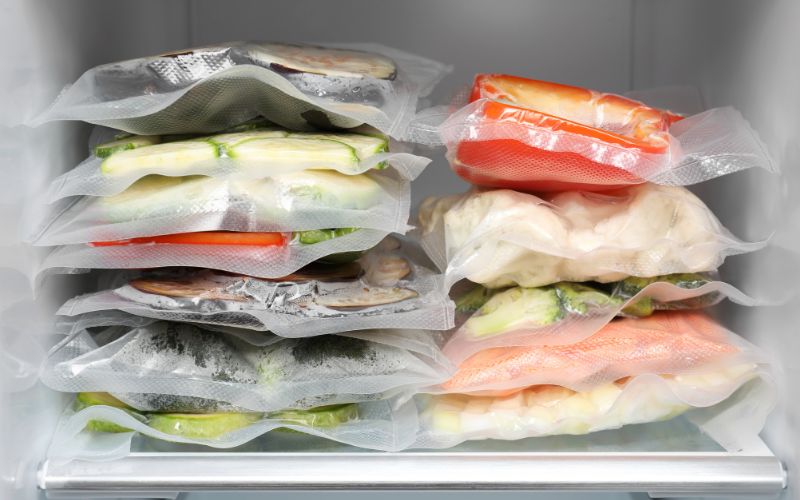
If you find yourself with some leftover zucchini that has already been cut up, don’t worry! You can still store it, but using it as soon as possible is always a good idea. To keep your fresh-cut zucchini fresh, place it in the crisper drawer of your refrigerator. Store it in an airtight container or a zip-top bag tightly sealed.
By doing so, you can extend the shelf life of your zucchini for about four or five days. However, if you have made zoodles from your zucchini, finding another way to use them immediately is best. Storing zoodles in the fridge for an extended time will cause them to become soggy and limp. So, enjoy your zoodles promptly to savor their delightful texture and taste.
How to Store Zucchini in the Freezer
Fear not if you have excess squash as the summer season ends! A simple solution to prevent your zucchini from going to waste is freezing it. However, it is crucial to follow the correct procedure to avoid ending up with a mushy mess. By storing it correctly, zucchini can be preserved in the freezer for up to three months, allowing you to enjoy its deliciousness even after summer has faded.
One method for freezing zucchini involves shredding it using a box grater. After slicing, you can steam the zucchini, allow it to cool, and carefully pack it into heavy-duty resealable bags. This approach works exceptionally well for recipes for shredded zucchini, such as the beloved zucchini bread.
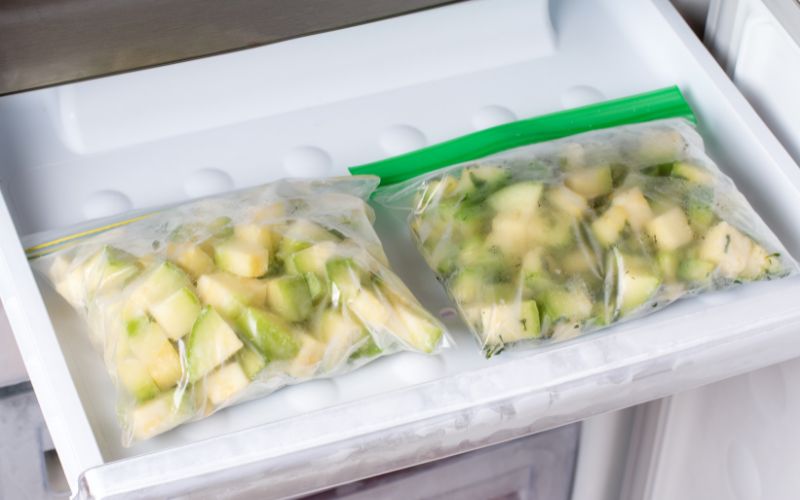
Alternatively, if you prefer to have zucchini slices or zoodles (zucchini noodles), you can cut them up or spiralize them before proceeding. To maintain their texture and prevent them from sticking together, blanch the slices or zoodles in hot water for a brief minute. Once blanched, remove them from the water and allow them to dry. Next, spread them out on a baking sheet and place them in the freezer for an hour or two. Once sufficiently chilled, transfer the slices or zoodles into freezer-safe bags before returning them to the freezer for long-term storage.
How to Blanch Zucchini Before Freezing
You have the option to freeze zucchini to preserve it for future use. However, it is important to blanch the zucchini before freezing. Blanching involves submerging the vegetables in hot water, which assists in retaining their valuable nutrients. Cut the zucchini into cubes or slices to begin the blanching process. Next, place the zucchini into a pot of salted boiling water and allow it to blanch for one to two minutes.
After the blanching is complete, it is essential to halt the cooking process promptly. This can be achieved by transferring the blanched zucchini directly into an ice-water bath, which should be prepared in a large bowl. Immerse the zucchini in the ice-water bath for approximately one minute. Following this step, allowing the zucchini to drain in a colander and pat dry using a paper towel is advisable.
How to Defrost Zucchini
Thawing zucchini is a relatively simple task that can be accomplished in several ways. One popular method is to place the freezer-safe bag containing the zucchini in the refrigerator overnight. This gradual thawing process allows the zucchini to defrost slowly and retain its texture and flavor.
However, if time is of the essence, a couple of quicker options are available. You can dunk the frozen zucchini bag in a warm water bowl. The warm water helps to expedite the thawing process by transferring heat to the zucchini. Another option is to use the microwave, but caution must be exercised to prevent overcooking. It is recommended to thaw the zucchini at half power in the microwave to ensure it doesn’t cook prematurely.
FAQs
How do you store zucchini long-term?
Don’t hesitate to freeze your zucchini if you are abundant in this versatile vegetable. To ensure the best results, start by patting the zucchini dry to remove any excess moisture. Next, carefully pack the zucchini into freezer bags, eliminating as much air as possible to prevent freezer burn. It’s also a good idea to freeze the zucchini in quantities you typically use in your recipes, making it more convenient when it comes time to thaw and cook. Lastly, label and date each freezer bag to easily track how long the zucchini has been frozen. With these simple steps, you can confidently freeze your zucchini and enjoy its fresh flavor and texture for up to three months.
How long do zucchini last in the fridge?
Did you know that storing whole zucchini in the fridge can help prolong its freshness for up to a week? It’s a great way to ensure you have delicious zucchini whenever needed. On the other hand, freezing is the way to go if you have some cut zucchini that you want to preserve for a more extended period. By storing cut zucchini in the freezer, you can extend its lifespan for up to three months. This means you can enjoy zucchini’s taste even when it’s out of season. So whether you prefer your fresh or frozen zucchini, there are ways to ensure it lasts and stays delicious for longer.
Does zucchini go bad if not refrigerated?
If you hold it at room temperature, typically around 68-72 degrees Fahrenheit, it will not last longer than an hour before it worsens. However, if you choose to store zucchini on the counter, away from direct sunlight and excessive heat, it can last up to a week. It is important to note that before holding the zucchini, you should refrain from washing them as this can introduce moisture and promote spoilage. Another helpful tip is to place the zucchini in a breathable container, such as a paper bag or perforated plastic bag, to allow for proper air circulation. On the other hand, if you have already cooked the zucchini, it will generally stay good for up to two days when refrigerated.
How do you preserve raw zucchini?
Freezing zucchini is a fantastic method to prolong its lifespan, but it requires more than simply placing a handful of squash into your freezer. When you thaw raw zucchini, it tends to become weepy and watery. To properly preserve it, it is advisable to chop the zucchini and blanch it beforehand. This process helps maintain its appealing texture and vibrant color and significantly extends its freshness.
Does zucchini last longer in the fridge or on the counter?
You do not have to refrigerate zucchini, but it is highly recommended as the optimal storage method because it significantly extends its shelf life. When zucchini is left at room temperature, it will maintain its quality for a relatively short period, typically ranging from 2 to 4 days. However, refrigerating zucchini can prolong its freshness and lifespan for up to two weeks. This simple refrigeration practice can significantly enhance your zucchini’s longevity and ensure you can enjoy its delicious flavors for an extended period.
Can I freeze zucchini without shredding?
To ensure thorough cleaning, it is essential to wash the zucchini diligently, paying close attention to every nook and cranny. Take the extra step of removing both the stem and the blossom ends, as they can add an undesirable taste to your dish. Once these preparations are complete, you can transform the zucchini into your desired form – for tantalizing noodles, delectable slices, or finely shredded pieces. For those who prefer the firmness of noodles or slices, arrange them in a single layer on a baking sheet, and freezing until they reach a solid state is recommended. This process typically takes around two hours, allowing ample time for the zucchini to become delightfully frozen.
How do you freeze zucchini without blanching?
To properly freeze raw zucchini for future use in delightful smoothies, comforting soups, and luscious sauces, we must thoroughly wash and dry the zucchini to ensure its cleanliness. Once that step is complete, we can prepare the zucchini for freezing. With a sharp knife, we carefully slice the zucchini into slices that measure approximately ½ to 1 inch in thickness, making sure to discard the ends for optimal taste and texture. Now that our zucchini is perfectly sliced, it’s time to move on to the next step.
We take a freezer bag and place the zucchini slices inside, arranging them flat to ensure even freezing and easy portioning later. Almost there! We seal the freezer bag virtually, leaving just a tiny opening. With the help of a humble straw, we remove any excess air from the pack, ensuring that our precious zucchini slices are protected from freezer burn. Once the bag is thoroughly sealed, we are ready to freeze our zucchini slices, allowing them to preserve their freshness and nutrients until prepared to use them in our culinary creations.
When we incorporate our frozen zucchini into a recipe, there’s no need to thaw them beforehand. Add the frozen zucchini slices directly to your masterpiece, letting them work their magic and infuse your dish with vibrant flavors and wonderful texture.

